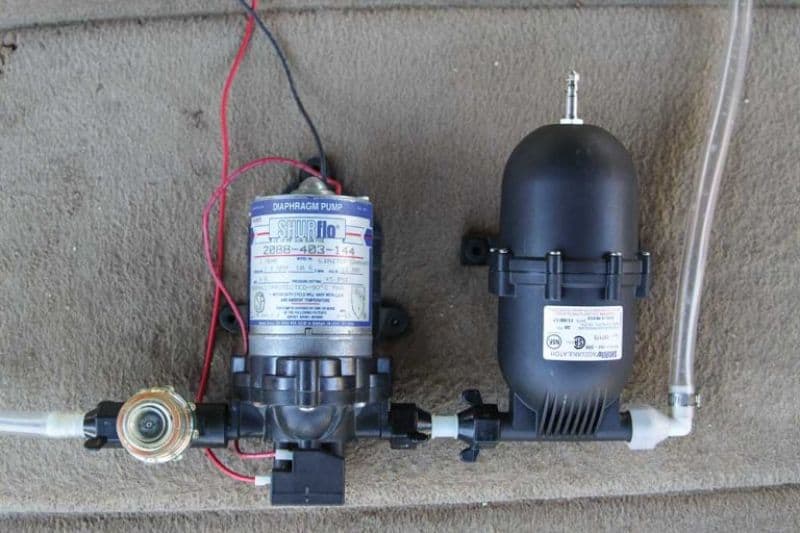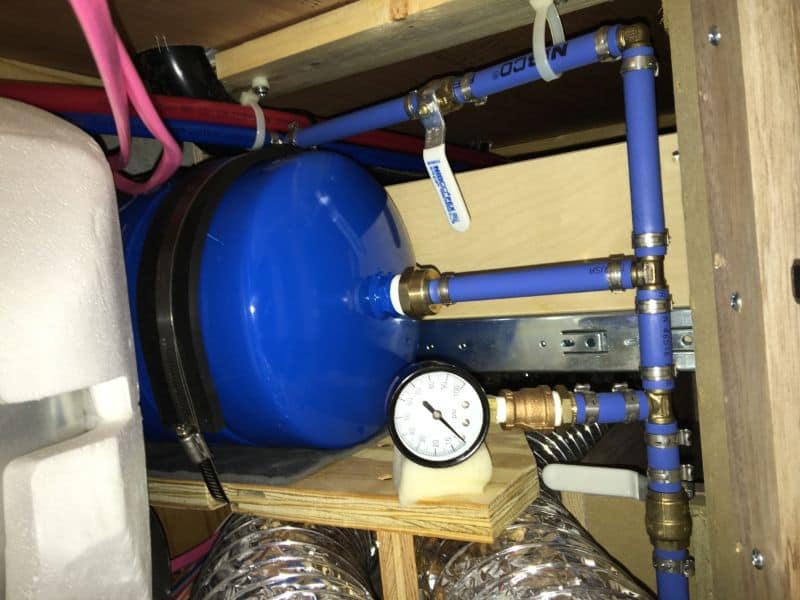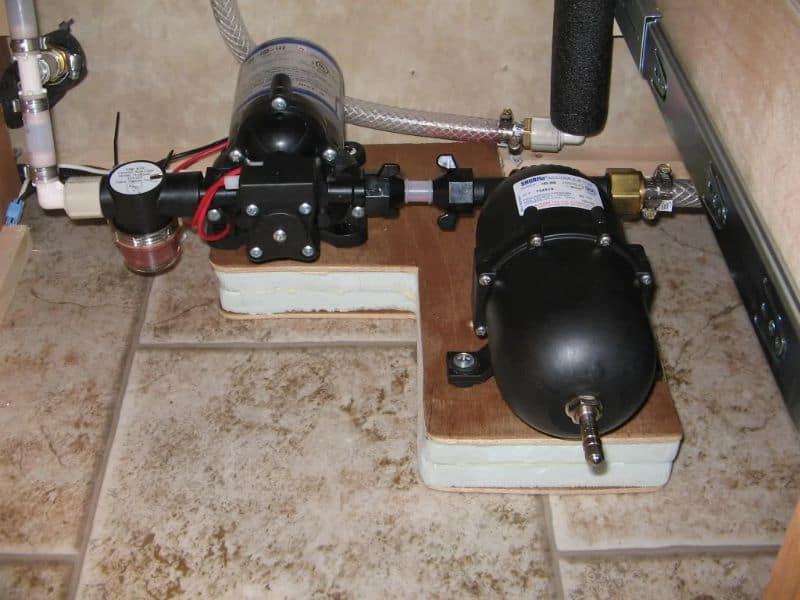Most RV water supply systems rely on an on-demand water pump. These pumps have a built-in pressure switch that triggers on/off operation. When the pressure dips – such as when you open a faucet – then the pump turns on. When the pressure rises – such as when you close the tap – the pump shuts off.
Sounds great in theory. Open tap; pumps turns on. Close tap; pump shuts off. But let’s consider the physics a little closer, shall we?
The Obnoxious Problem of Pump Short Cycling
What happens if water is just trickling out of the faucet?
- Well, the pump turns on and rapidly pumps water back into the pipes.
- But remember, water isn’t compressible. So the pipes fill up faster than the tap water trickles out. The pressure rises and the pump shuts off at its cut-off pressure.
- But … your faucet is still open, isn’t it? So after a few more drops trickle out, pressure drops to below the pump’s cut-in pressure, the pump turns on again …
- And the cycle continues!
This is called “short cycling,” and it’s an awful hassle. Short cycling causes the following problems:
- Premature wear and tear on your RV water pump
- Shocks your water system with pressure spikes.
- Causes loud, obnoxious noises from pump whine or water hammer.
- Interrupts the smooth flow of water.
- Draws more power due to the motor inrush current (small effect, but nonetheless).
What Is an RV Accumulator Tank?
If your RV has a water hammer or short cycling problem, you should look into an accumulator tank.

An accumulator tank smooths water flow and reduces pump cycling. It’s a common misconception to think that an accumulator tank is just a water overflow tank, but that’s not true. They have internal pressurized air bladders. They are miniature expansion tanks, with two compartments separated by a rubber diaphragm. In other words, an accumulator tank stores pressure.
So when you wake up to pee in the middle of the night, your (obnoxiously loud) pump doesn’t need to kick on. Your accumulator tank provides the pressure. After a handful of toilet flushes, your pump kicks on for a few minutes to recharge the system – and you’re good to go for another few flushes!
An accumulator tank is installed in the main water supply line after the pressure pump. When installed between the pressure pump and the water heater, it will deliver consistent pressure of both hot and cold water.
To recap, here are some of the benefits of an accumulator tank:
- Smooths the flow of water*
- Reduces pump cycling
- Reduces noise from pump motor
- Protects your piping from water hammer
- Dampens pump pulsations
*This is especially important if you have an instant water heater.
Do I Need an Accumulator Tank for My RV?
The “typical” RV water supply system I’ve described above would be improved with an accumulator tank. The cost is minimal, around $30-$50 for the part plus the fittings for installation.
Important note: Don’t skimp on the size! This is one case where bigger really is better. The typical RV accumulator tank is 0.75-1 liter, but many RVers report better pulsation-dampening results from 2-gallon expansion tanks like the Shurflo 3400 Series. However, you should use an expansion tank rated for drinking water!
But did you know that not all RVs need an accumulator tank?
- A bypass pressure pump, like the Pentair Shurflo Revolution 4008, doesn’t require an accumulator tank. A bypass pump uses a variable bypass valve to recirculate water from the output back to the input in low-flow conditions (kind of like an EGR valve). Check the pump manufacturer’s recommendations; some allow an accumulator tank alongside a bypass pump; some don’t.
- A variable-speed pump, like the Remco AquaJet or Shurflo Smart Sensor, eliminates short cycling throughout the entire normal range. However, these pumps are not inexpensive, especially compared to a $30-$50 accumulator tank! Again, check the pump manufacturer’s recommendations regarding accumulator tanks.
Things to Know About Accumulator Tank Maintenance and Installation
- The smaller accumulator tanks can be installed just about anywhere, whereas the larger expansion tanks will take up part of a storage compartment.
- Some accumulator tanks, like pumps, should be attached with flex hoses to the PEX tubing.
- Most tanks have a Schrader valve which can be pressurized with a tire inflator, bike pump or hand pump.
- Accumulator tanks should not be stored at high water pressure for long periods.
- Accumulator tanks will be damaged by momentary high pressure. Your plumbing system should have a pressure relief valve (usually either 100 or 125 psi).
- Pressure precharged should be checked seasonally. For best performance, precharge should normally match (or be 2-3 psi less than) the pump cut-in or “turn on” pressure. Check your manual.
- If you don’t want to winterize your accumulator tank, install a shut-off valve between it and the main water line.
Key Takeaways About RV Accumulator Tanks
- Accumulator tanks (aka expansion tanks) store pressure to reduce water hammer, decrease pump cycling, and smooth water flow.
- Most RVs don’t come with accumulator tanks because they aren’t deemed essential.
- If your RV has a bypass water pump or variable-speed pump, you may not need an accumulator tank.
- For best performance, the accumulator tank pressure should usually match or be just below the pump cut-in pressure. Check your Owner’s Manual.


Leave a Reply